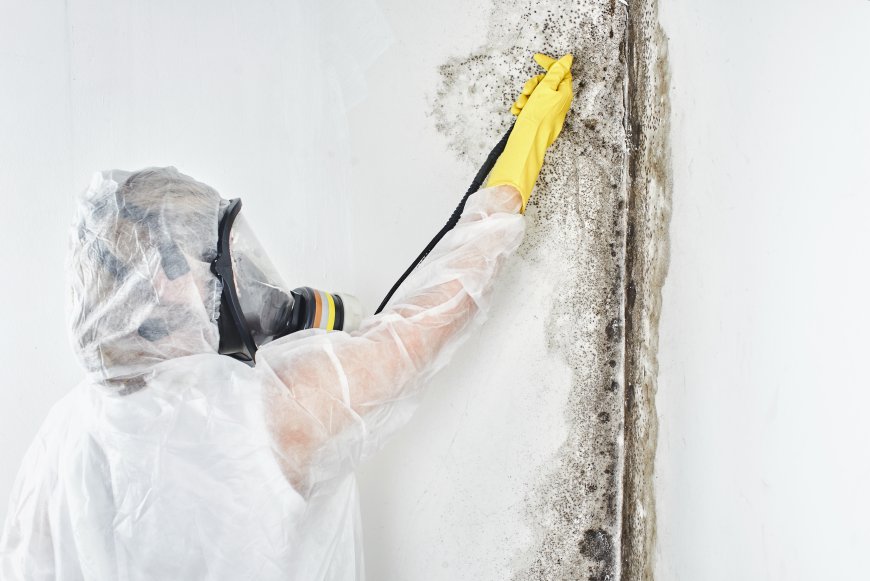Everything You Need to Know About Mold Testing in Dallas: Timing, Reasons, and Methods
Let's explore everything you need to know about mold testing in Dallas—when you should consider it, why it matters, how professionals conduct it, and what different results might mean for your home and health.

Living in Dallas means dealing with a climate that can create perfect conditions for mold growth. Our hot, humid summers, occasional flooding, and even the way our homes are constructed can all contribute to mold problems that might affect your health and your home's structural integrity. Whether you're a homeowner, prospective buyer, landlord, or tenant, understanding mold testing is an essential part of maintaining a healthy living environment in North Texas.
Let's explore everything you need to know about mold testing in Dallas—when you should consider it, why it matters, how professionals conduct it, and what different results might mean for your home and health.
Understanding Mold in the Dallas Climate
Before diving into testing specifics, it's important to understand why Dallas homes are particularly susceptible to mold issues.
The Dallas Mold Environment
Dallas experiences several climate factors that create favorable conditions for mold growth:
-
High Humidity Levels: During summer months, Dallas's humidity regularly exceeds 70%, creating moisture-rich environments where mold thrives. Even with air conditioning running constantly, many homes struggle to maintain indoor humidity below 60% (the threshold above which mold growth accelerates).
-
Temperature Fluctuations: Our dramatic temperature shifts between seasons—and sometimes within a single day—can create condensation issues inside walls and attics when warm, humid air meets cooler surfaces.
-
Seasonal Storms: Spring thunderstorms and occasional flooding create water intrusion problems that may not dry properly, especially in poorly ventilated areas.
-
Construction Practices: Many Dallas homes built during construction booms prioritized energy efficiency without adequate consideration for ventilation, creating tightly sealed environments where moisture can become trapped.
Common Mold Types in Dallas Homes
While hundreds of mold species exist, several types appear frequently in Dallas properties:
-
Aspergillus: Often found in air conditioning systems and ductwork—a particular concern given how extensively we use cooling systems in Dallas.
-
Cladosporium: Commonly appears on fabrics and wood surfaces in damp areas like bathrooms and basements.
-
Stachybotrys (often called "black mold"): Requires consistent moisture and typically grows on high-cellulose materials like drywall, paper, and cardboard.
-
Penicillium: Often found in water-damaged furnishings and carpeting, especially after flooding events.
-
Alternaria: Frequently appears in damp shower areas and under sinks with leaky plumbing.
Understanding these varieties matters because different types present varying health risks and remediation challenges, which proper testing can identify.
When Should You Consider Mold Testing in Dallas?
Unlike some home maintenance tasks that follow a regular schedule, mold testing is typically conducted in response to specific situations. Here are the most common scenarios when Dallas residents should consider professional mold testing:
Visual Signs of Mold Growth
The most obvious reason to test is when you can actually see what appears to be mold growth. This might include:
-
Discoloration on walls, ceilings, or flooring (particularly black, green, or brown spots)
-
Fuzzy or slimy growths in bathrooms, kitchens, or laundry areas
-
Visible growth around windows or areas with condensation
However, just because you can see something suspicious doesn't mean you know what type of mold you're dealing with or its extent—that's where testing becomes valuable.
Water Damage Events
In Dallas, severe thunderstorms, plumbing failures, and roof leaks can all lead to significant water intrusion. Consider mold testing:
-
After any flooding event, particularly if drying took longer than 24-48 hours
-
Following repair of a plumbing leak, especially if it went undetected for a period of time
-
When water stains appear on ceilings or walls
-
After the roof leaks during Dallas's heavy spring storms
Even when areas appear dry, moisture can remain trapped in building materials, creating conditions for hidden mold growth.
Persistent Musty Odors
That distinctive musty smell is often your first warning sign of hidden mold. If you notice persistent odors, particularly:
-
In bathrooms with insufficient ventilation
-
In closets against exterior walls
-
In finished basements (common in some North Dallas neighborhoods)
-
Near HVAC equipment or around vents
These odors typically indicate active mold growth that may be occurring inside walls, under flooring, or in other concealed areas.
Real Estate Transactions
Mold testing has become increasingly common during Dallas real estate transactions:
-
For Buyers: Including mold testing as part of your home inspection process can uncover hidden problems before purchase, particularly in older homes or properties that have been vacant.
-
For Sellers: Pre-listing mold inspections can identify and address issues before they complicate a sale, especially important in Dallas's competitive real estate market where buyers have become increasingly cautious about environmental hazards.
Health Symptoms
Perhaps the most compelling reason for mold testing is when occupants experience unexplained health issues that improve when away from home. Consider testing if residents experience:
-
Persistent coughing or throat irritation
-
Worsening asthma or allergies
-
Unexplained headaches
-
Chronic sinus infections or congestion
-
Fatigue or difficulty concentrating
Dallas allergists and pulmonologists increasingly recommend mold testing for patients with respiratory symptoms that don't respond to standard treatments, particularly during our humid summer months.
After Purchasing a Foreclosed Property
Given Dallas's real estate cycles, foreclosed properties occasionally come on the market. These homes may have sat vacant with utilities disconnected, creating perfect conditions for mold growth. Testing before renovation is strongly recommended.
Before and After Major Renovation Projects
Major renovations often reveal previously hidden problems. Consider testing:
-
Before beginning work to establish baseline conditions
-
During renovation if suspicious materials are uncovered
-
After completion to ensure construction practices didn't create new moisture issues
Why Mold Testing Matters in Dallas Homes
Understanding the importance of mold testing helps justify the investment and take appropriate action based on results.
Health Implications
Mold exposure affects Dallas residents in various ways:
-
Allergic Reactions: Common responses include sneezing, runny nose, red eyes, and skin rashes. With Dallas already being a challenging environment for allergy sufferers, mold adds another dimension to respiratory distress.
-
Asthma Triggers: Mold can induce asthma attacks in sensitive individuals, particularly children and the elderly. Given Dallas's air quality challenges during the summer months, this creates a compound problem for many residents.
-
Infections: People with compromised immune systems may develop serious infections when exposed to certain molds.
-
Toxic Reactions: Some molds produce mycotoxins that can cause more serious neurological symptoms and chronic inflammatory response syndrome (CIRS).
Professional testing identifies specific mold species, helping healthcare providers connect symptoms to potential causes.
Property Value Protection
In Dallas's value-conscious real estate market, mold problems can significantly impact property values:
-
Documented mold issues must be disclosed to future buyers
-
Lenders may require remediation before financing approval
-
Insurance carriers may restrict coverage for properties with a history of mold claims
Professional testing provides documentation of conditions, whether confirming a property is mold-free or establishing the extent of problems requiring remediation.
Identifying Root Causes
Perhaps most importantly, professional mold testing helps identify underlying moisture sources that must be addressed to prevent recurrence. In Dallas homes, common culprits include:
-
Improper grading around foundations
-
Roof or flashing failures
-
Plumbing leaks
-
Inadequate bathroom ventilation
-
HVAC condensation issues
-
Window seal failures
Without addressing these root causes, mold will simply return after remediation.
Types of Mold Testing Methods Used in Dallas
Not all mold testing is created equal. Understanding the options helps you select the most appropriate testing for your situation.
Air Sampling
The most common testing method in Dallas involves capturing air samples to identify airborne mold spores:
-
How it works: Air sampling devices draw measured volumes of air across collection media, capturing mold spores for laboratory analysis.
-
Best for: Identifying airborne mold without visible growth, comparing indoor and outdoor mold levels, and assessing overall air quality.
-
Limitations: Results represent only a snapshot of conditions at the moment of testing. Dallas's seasonal variations mean levels can fluctuate significantly throughout the year.
Proper air sampling typically includes collecting outdoor air samples as baseline comparisons, since Dallas's outdoor air naturally contains many mold spores, depending on the season.
Surface Sampling
When visible growth is present, surface sampling provides identification:
-
How it works: Professionals collect samples directly from affected materials using swabs, tape lifts, or bulk material collection.
-
Best for: Identifying specific mold species growing on visible surfaces and determining appropriate remediation approaches.
-
Limitations: Only identifies mold at specific testing locations, potentially missing problems elsewhere in the property.
Surface sampling is particularly important when distinguishing between concerning mold growth and harmless discoloration, such as mineral deposits common in Dallas homes with hard water.
Cavity Testing
Given our construction methods and climate challenges, many Dallas mold problems occur inside wall cavities:
-
How it works: Small holes are drilled to access wall cavities, then air or material samples are collected from these spaces.
-
Best for: Confirming suspected hidden mold growth without destructive investigation.
-
Limitations: Limited to specific test locations; may miss problems in untested areas.
This method is particularly valuable in Dallas's pier-and-beam homes, where crawlspaces can harbor significant mold growth, or in homes where previous water intrusion events suggest the possibility of hidden growth.
ERMI Testing (Environmental Relative Moldiness Index)
A more comprehensive approach is gaining popularity in Dallas:
-
How it works: Dust samples collected from the home are analyzed for DNA evidence of 36 mold species, creating a relative "moldiness" score.
-
Best for: Comprehensive assessment of potential mold exposure, particularly when health concerns are the primary motivation for testing.
-
Limitations: More expensive than traditional methods; results can be complex to interpret without professional guidance.
ERMI testing has become increasingly common when Dallas residents work with environmental medicine specialists or when legal documentation of conditions is required.
Moisture Mapping
Not technically mold testing but often performed alongside it:
-
How it works: Using infrared cameras and moisture meters, technicians identify areas of elevated moisture that could support mold growth.
-
Best for: Finding potential problem areas before visible mold appears and identifying sources of water intrusion.
-
Limitations: Indicates only potential for mold growth rather than confirming its presence.
In Dallas's humid environment, moisture mapping helps distinguish between condensation issues (common during summer months) and actual plumbing or envelope failures requiring repair.
The Professional Mold Testing Process in Dallas
Understanding how testing typically unfolds helps set appropriate expectations.
Initial Assessment
A thorough testing process begins with inspection:
-
Visual examination of the property, focusing on high-risk areas like bathrooms, kitchens, utility rooms, and areas with previous water issues.
-
History gathering about the property, including previous water damage, renovations, and any symptoms experienced by occupants.
-
Moisture readings of suspicious areas to identify elevated moisture levels that might support mold growth.
-
Development of sampling strategy based on observations and concerns.
The best inspectors take time to understand your specific concerns rather than applying a one-size-fits-all approach.
Sample Collection
Proper collection protocol is critical for accurate results:
-
Control samples are established first, typically including outdoor air samples for comparison with indoor conditions.
-
Systematic sampling follows a logical pattern rather than random testing.
-
Proper documentation of each sample location, usually including photographs and detailed notes.
-
Chain of custody procedures ensure samples aren't contaminated during handling and transport.
Laboratory Analysis
Once collected, samples are sent to specialized laboratories:
-
Microscopic examination identifies and quantifies mold spores present in air samples.
-
Cultured growth from some samples allows for more specific species identification.
-
DNA analysis for advanced testing methods like ERMI.
In Dallas, several qualified laboratories process samples, typically returning results within 2-5 business days.
Comprehensive Reporting
Professional testing should culminate in clear documentation:
-
Detailed findings identifying types and concentrations of mold present.
-
Comparative analysis showing how indoor levels compare to outdoor baseline levels.
-
Interpretation of what the results mean for the property and its occupants.
-
Recommendations for next steps, which might include additional investigation, remediation, or moisture control measures.
Thorough reports become important documentation for insurance claims, real estate transactions, or discussions with healthcare providers.
Understanding Mold Testing Results in Dallas Homes
Interpreting results requires understanding several factors:
Spore Counts and Significance
Mold reports typically quantify spores per cubic meter of air, but what do these numbers mean?
-
Normal conditions: Indoor spore counts should generally be lower than outdoor counts, with similar distribution of species.
-
Concerning conditions: Indoor counts are significantly higher than outdoor levels, particularly of species not predominant outdoors, suggesting an indoor growth source.
-
Species significance: Some molds (like Stachybotrys) are rarely found in outdoor air samples in Dallas; their presence indoors at any level often indicates a problem.
Context matters—during Dallas's spring, outdoor mold counts naturally increase, affecting what's considered "normal" for indoor environments.
Common Result Scenarios in Dallas Properties
Several patterns appear frequently in local testing:
Scenario 1: Elevated Aspergillus/Penicillium
When air samples show elevated levels of these common molds:
-
Typical source: HVAC systems, particularly when condensate drainage is problematic (a common issue in Dallas's humid climate).
-
Implications: May indicate maintenance issues rather than major water intrusion. However, these species can still cause significant health issues for sensitive individuals.
-
Next steps typically involve: HVAC cleaning, addressing condensate drainage problems, and improving filtration.
Scenario 2: Elevated Stachybotrys (Black Mold)
Finding this species requires attention:
-
Typical source: Chronically wet building materials, particularly drywall. In Dallas homes, this often relates to slow plumbing leaks or exterior drainage problems, allowing water to penetrate walls.
-
Implications: Suggests significant moisture problems and potential for mycotoxin exposure.
-
Next steps typically involve: Identifying and repairing moisture source, professional remediation following proper containment protocols, and sometimes replacement of affected building materials.
Scenario 3: Elevated Cladosporium
This finding has specific implications:
-
Typical source: It often indicates exterior mold (common in Dallas homes with shaded areas) being drawn indoors or growth on interior organic materials in humid environments.
-
Implications: May suggest envelope issues or ventilation problems rather than active water intrusion.
-
Next steps typically involve: Addressing ventilation, checking exterior growth near windows/doors, and evaluating humidity control.
When No Mold Is Detected
Sometimes testing finds nothing concerning despite symptoms or suspicions:
-
This could mean the timing wasn't right (mold levels fluctuate based on activity and disturbance)
-
The testing method might not have been appropriate for the situation
-
Symptoms might be caused by other indoor air quality issues common in Dallas, such as dust mite allergens or chemical exposures
In these cases, consider expanded testing approaches or exploring other potential causes for concerns.
After the Test: Next Steps Based on Dallas Mold Findings
Once you have testing results, appropriate action depends on the findings:
For Minor or Localized Issues
When testing reveals limited problems typically found in Dallas homes:
-
Address moisture sources first: Repair leaky faucets, improve bathroom ventilation, correct drainage issues around the foundation, or service HVAC systems to reduce condensation.
-
Improve environmental conditions: Use dehumidifiers during humid months (particularly important in Dallas's summer), increase air circulation, and maintain consistent indoor temperatures to reduce condensation risk.
-
Consider DIY cleaning for very small areas: Surface mold covering less than 10 square feet on non-porous surfaces can sometimes be addressed by homeowners using appropriate cleaning methods and protective equipment.
-
Follow up with preventative measures: Regular maintenance of areas prone to moisture in Dallas homes, like checking attics after heavy storms and monitoring humidity levels during summer months.
For Significant or Widespread Findings
Substantial mold issues require professional intervention:
-
Professional remediation consultation: Get detailed assessments of work needed based on testing results.
-
Containment planning: Ensuring work doesn't spread contaminants throughout the home.
-
Address underlying causes: Major plumbing repairs, foundation waterproofing, drainage improvements, or HVAC system modifications may be necessary.
-
Post-remediation verification testing: Follow-up testing after work confirms successful remediation.
In Dallas's climate, comprehensive remediation often involves not just removing existing mold but implementing improved moisture control systems to prevent recurrence.
Documentation and Disclosure Considerations
Proper handling of testing paperwork matters:
-
For homeowners: Maintain records of testing, remediation, and follow-up testing for future reference and potential disclosure requirements.
-
For sellers: Understand Texas disclosure requirements regarding known mold issues.
-
For buyers: Request copies of any previous testing or remediation documentation.
-
For insurance purposes: Maintain documentation that may be required for claims or coverage verification.
Preventing Future Mold Problems in Dallas Homes
Testing identifies current conditions, but prevention requires ongoing attention:
Dallas-Specific Moisture Control Strategies
Our regional climate demands specific approaches:
-
Foundation maintenance: Given our expansive clay soils, maintaining consistent soil moisture around foundations helps prevent shifting that can create plumbing and envelope breaches.
-
Proper landscaping grading: Ensuring water flows away from the home, particularly important during our intense thunderstorm season.
-
Attic ventilation: Critical in Dallas's heat to prevent condensation when hot air meets cooler surfaces during air conditioning season.
-
Humidity control: Using whole-house dehumidifiers during humid months can maintain indoor levels below 55%, inhibiting mold growth.
-
Regular inspection of potential problem areas: Checking under sinks, around windows, and in bathrooms weekly for early signs of moisture issues.
Seasonal Maintenance Calendar for Dallas Homes
Timing preventative measures with our seasonal patterns:
-
Spring (storm season): Check roof, gutters, and drainage systems before heavy rains; inspect attic after storms for leaks.
-
Summer (humidity season): Monitor and maintain appropriate indoor humidity levels; check condensate drainage from air conditioning systems regularly.
-
Fall: Clean gutters after leaf drop; inspect weather sealing around doors and windows before temperature fluctuations begin.
-
Winter: Monitor areas where condensation might form when warm indoor air meets cold surfaces, particularly in older homes with less insulation.
Special Considerations for Different Dallas Housing Types
Testing and prevention strategies vary based on construction:
Pier and Beam Homes
Common in older Dallas neighborhoods like Lakewood and M Streets:
-
Crawlspace considerations: These areas frequently develop mold due to ground moisture and poor ventilation.
-
Testing approach: Should include crawlspace air quality and structural material sampling.
-
Prevention focus: Proper crawlspace ventilation, moisture barriers, and foundation perimeter drainage.
Slab Foundation Homes
Predominant in most Dallas suburbs:
-
Testing focus: Areas where plumbing runs through or under the slab require special attention.
-
Common issues: Slab leaks can go undetected for extended periods, creating hidden mold behind walls or under flooring.
-
Prevention strategies: Regular inspection for signs of water intrusion; prompt attention to any signs of slab leaks.
Multi-Family Properties
For Dallas condos and apartments:
-
Shared wall considerations: Moisture problems in adjacent units can affect your space.
-
Testing challenges: Limited access to shared spaces may complicate a comprehensive assessment.
-
Prevention limitations: May require coordination with HOA or property management for comprehensive solutions.
The Cost of Mold Testing in Dallas
Understanding typical expenses helps with planning:
Fee Structures
Dallas mold testing typically follows these pricing models:
-
Basic visual inspection only: $200-350 (limited value without sampling)
-
Limited sampling: $350-500 (typically 3-5 air samples)
-
Comprehensive inspection with multiple sample types: $500-1,000
-
ERMI or other advanced testing: $600-1,200
Factors affecting cost include:
-
Property size and complexity
-
Number and types of samples collected
-
Accessibility of areas requiring inspection
-
Whether specialized equipment like infrared cameras is used
Cost-Benefit Analysis
When evaluating the expense:
-
Compare testing costs against potential remediation expenses if problems go undetected
-
Consider health impacts and associated medical costs
-
Factor in peace of mind, particularly for families with children, the elderly, or immunocompromised members
-
Weigh potential impact on property value and saleability
Conclusion: Making Informed Decisions About Dallas Mold Testing
Living in Dallas means accepting our climate's challenges while taking proactive steps to maintain healthy indoor environments. Mold testing provides valuable information that helps homeowners, buyers, sellers, and tenants make informed decisions about properties.
Rather than fearing mold issues, approach testing as a tool for understanding your environment and addressing problems early before they affect health or property values. With Dallas's humidity challenges, some degree of vigilance is simply part of responsible homeownership in our region.
The most successful approach combines:
-
Awareness of warning signs that suggest testing is needed
-
Selection of appropriate testing methods for specific situations
-
Proper interpretation of results in context
-
Prompt addressing of any identified issues
-
Implementation of preventative measures suited to our unique climate
By understanding when, why, and how to conduct mold testing, Dallas residents can enjoy healthier homes that maintain their value and provide safe, comfortable environments regardless of what our challenging climate brings.













































































































![Are AI Chatbots Replacing Search Engines? AI vs Google [New Research]](https://www.orbitmedia.com/wp-content/uploads/2025/05/How-often-are-we-using-AI-chatbots_.webp)


















































